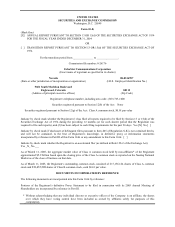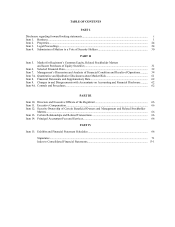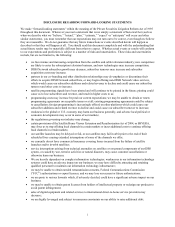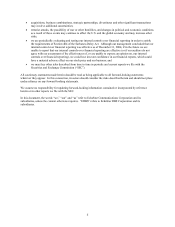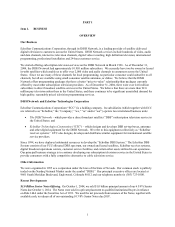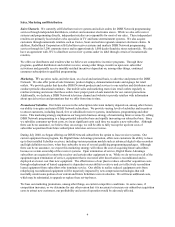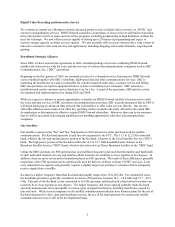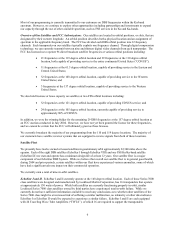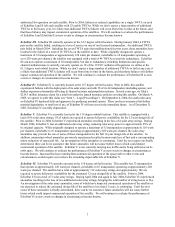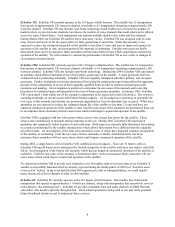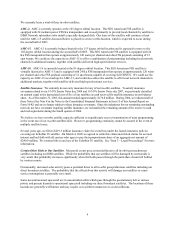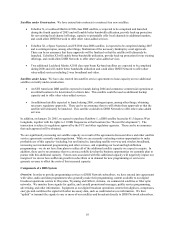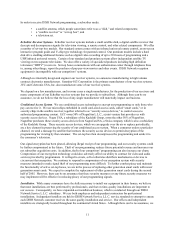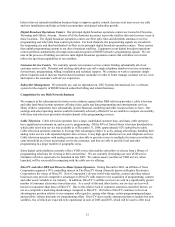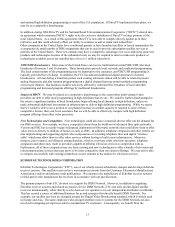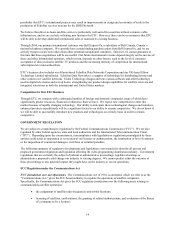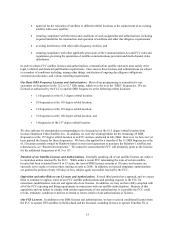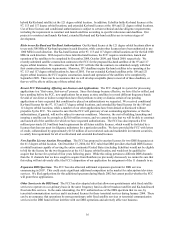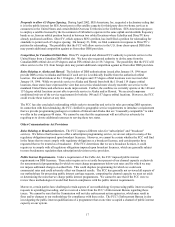Dish Network 2004 Annual Report Download - page 15
Download and view the complete annual report
Please find page 15 of the 2004 Dish Network annual report below. You can navigate through the pages in the report by either clicking on the pages listed below, or by using the keyword search tool below to find specific information within the annual report.7
authorized for operation on each satellite. Prior to 2004, failures or reduced capabilities on a single TWTA on each
of EchoStar I and II left each satellite with 23 usable TWTAs. While we don’t expect a large number of additional
TWTAs to fail in any year, it is likely that additional TWTA failures will occur from time to time in the future, and
that those failures may impact commercial operation of the satellites. We will continue to evaluate the performance
of EchoStar I and EchoStar II as new events or changes in circumstances become known.
EchoStar III. EchoStar III currently operates at the 61.5 degree orbital location. During January 2004, a TWTA
pair on this satellite failed, resulting in a loss of service on one of our licensed transponders. An additional TWTA
pair failed in March 2004. Including the seven TWTA pairs that malfunctioned in prior years, these anomalies have
resulted in the failure of a total of 18 TWTAs on the satellite to date. While originally designed to operate a
maximum of 32 transponders at approximately 120 watts per channel, switchable to 16 transponders operating at
over 230 watts per channel, the satellite was equipped with a total of 44 TWTAs to provide redundancy. EchoStar
III can now operate a maximum of 26 transponders, but due to redundancy switching limitations and specific
channel authorizations it currently can only operate on 18 of the 19 FCC authorized frequencies we utilize at the
61.5 degree west orbital location. While we don’t expect a large number of additional TWTAs to fail in any year, it
is likely that additional TWTA failures will occur from time to time in the future, and that those failures will further
impact commercial operation of the satellite. We will continue to evaluate the performance of EchoStar III as new
events or changes in circumstances become known.
EchoStar IV. EchoStar IV is currently located at the 157 degree orbital location. Prior to 2004, this satellite
experienced failures with the deployment of its solar arrays and with 38 of its 44 transponders (including spares), and
further experienced anomalies affecting its thermal systems and propulsion systems. Several years ago, we filed a
$219.3 million insurance claim for a total loss under the launch insurance policies covering this satellite. On March 4,
2005, we agreed to settle this claim (see “Item 3 – Legal Proceedings”). On September 4, 2004, the south solar array
on EchoStar IV deployed fully and appears to be producing nominal current. There can be no assurance that further
material degradation, or total loss of use, of EchoStar IV will not occur in the immediate future. As of December 31,
2003, EchoStar IV was fully depreciated.
EchoStar V. EchoStar V is currently located at the 119 degree orbital location. This satellite is equipped with a
total of 96 solar array strings, 92 of which are required to assure full power availability for the 12-year design life of
the satellite. Prior to 2004, EchoStar V experienced anomalies resulting in the loss of 4 solar array strings. During
March 2004, EchoStar V lost an additional solar array string, reducing solar array power to approximately 95% of
its original capacity. While originally designed to operate a maximum of 32 transponders at approximately 110 watts
per channel, switchable to 16 transponders operating at approximately 220 watts per channel, the solar array
anomalies may prevent the use of some of those transponders for the full 12-year design life of the satellite. In
addition, momentum wheel anomalies previously experienced resulted in more rapid use of fuel and a corresponding
minor reduction of spacecraft life. An investigation of the anomalies is continuing. Until the root causes are finally
determined, there can be no assurance that future anomalies will not cause further losses which could impact
commercial operation of the satellite. EchoStar V is not currently carrying any traffic and is being utilized as an in-
orbit spare. We will continue to evaluate the performance of EchoStar V as new events or changes in circumstances
become known. Increased fuel use resulting from commercial operation of the spacecraft or other events and
circumstances would require us to reduce the remaining depreciable life of EchoStar V.
EchoStar VI. EchoStar VI currently operates at the 110 degree orbital location. This satellite has 32 transponders
that operate at approximately 120 watts per channel, switchable to 16 transponders operating at approximately 240
watts per channel. The satellite has a total of approximately 112 solar array strings and approximately 106 are
required to assure full power availability for the estimated 12-year design life of the satellite. Prior to 2004,
EchoStar VI lost a total of 3 solar array strings. During April 2004 and again in July 2004, EchoStar VI experienced
anomalies resulting in the loss of two additional solar array strings, bringing the total number of string losses to five.
An investigation of the solar array anomalies, none of which have impacted commercial operation of the satellite or
are expected to reduce the estimated design life of the satellite to less than 12 years, is continuing. Until the root
cause of these anomalies is finally determined, there can be no assurance future anomalies will not cause further
losses which could impact commercial operation of the satellite. We will continue to evaluate the performance of
EchoStar VI as new events or changes in circumstances become known.


